
Coral snakes are a large group of elapid snakes that can be divided into two distinct groups, the Old World coral snakes and New World coral snakes. There are 27 species of Old World coral snakes, in three genera, and 83 recognized species of New World coral snakes, in two genera. Genetic studies have found that the most basal lineages have origins in Asia, suggesting that the group originated in the Old World. While new world species of both genera are venomous, their bites are seldom lethal; only two confirmed fatalities have been documented in the past 100 years from the genus Micrurus. Meanwhile, snakes of the genus Micruroides have never caused a medically significant bite.

Micrurus is a genus of venomous coral snakes of the family Elapidae.
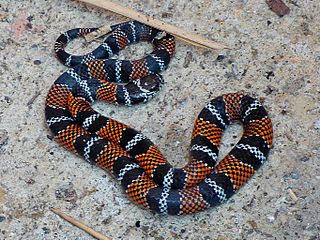
Erythrolamprus bizona, commonly known as the double-banded false coral snake, is a species of colubrid snake, which is endemic to northern South America and Central America.

Micrurus hemprichii, commonly known as Hemprich's coral snake and the worm-eating coral snake, is a species of venomous coral snake in the family Elapidae. The species is native to South America.

Micrurus nigrocinctus, commonly known as the Central American coral snake, is a species of a highly venomous snake in the family Elapidae. The species is endemic to Latin America from southern Mexico, Central America, to north Colombia. There are six recognized subspecies, including the nominate subspecies described here.
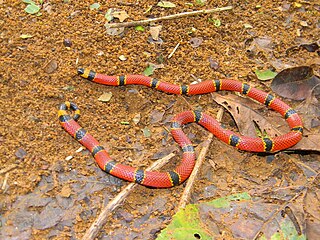
Micrurus browni, commonly known as Brown's coral snake, is a species of venomous snake in the family Elapidae. The species is native to Guatemala and southwestern Mexico. There are three recognized subspecies, including the nominate subspecies described here.

Bogert's coral snake is a species of venomous snake in the family Elapidae. The species is endemic to southern Mexico.

Micrurus lemniscatus, commonly known as the South American coral snake, is a species of venomous snake in the family Elapidae. The species is endemic to South America.
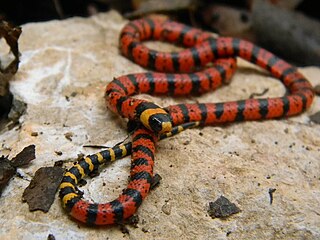
Micrurus diastema, commonly known as the variable coral snake, is a species of venomous snake in the family Elapidae. The species is endemic to southeastern Mexico and northern Central America. There are seven recognized subspecies.
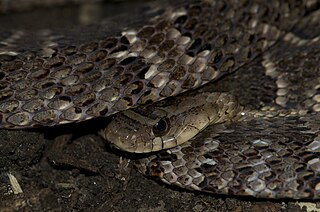
Xenodon rabdocephalus, commonly known as the false fer-de-lance, is a species of mildly venomous rear-fanged snake in the family Colubridae. The species is native to Central America and northern South America. There are two recognized subspecies.

Rhinobothryum bovallii, commonly known as the coral mimic snake or the false tree coral, is a species of snake in the family Colubridae. The species is native to Central America and northwestern South America.
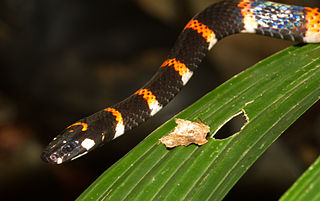
Pliocercus euryzonus, commonly known as Cope's false coral snake, is a species of snake in the subfamily Dipsadinae of the family Colubridae. The species is indigenous to southeastern Central America and northwestern South America. There are two recognized subspecies.

Micrurus mipartitus is a species of coral snake in the family Elapidae. It is found in South and Central America. The redtail coral snake is common in agricultural areas in Colombia. Its highly neurotoxic venom is known to cause seizures in its prey by activating nerve proteins responsible for seizures within it.

The Colombian longtail snake, also known commonly as the sock-headed snake and the white-headed snake, is a species of snake in the family Colubridae. The species, which is monotypic in the genus Enuliophis, is native to Central America and northern South America.

Micrurus averyi, also known commonly as Avery's coral snake and the black-headed coral snake, is a species of coral snake, a venomous snake in the genus Micrurus of the family Elapidae. The species is indigenous to northern South America.
Geophis godmani, also known commonly as Godman's earth snake, the yellow-bellied earth snake, and la culebra minadora de Godman in American Spanish, is a species of snake in the Family Colubridae. The species is native to Central America.

Geophis sartorii, also known commonly as Sartorius' snail-sucker and the terrestrial snail sucker, is a species of snake in the family Colubridae. The species is native to southern North America and Central America. There are two recognized subspecies.

Micrurus alleni, the arrow-headed coral snake or Allen's coral snake, is a species of snake of the family Elapidae.
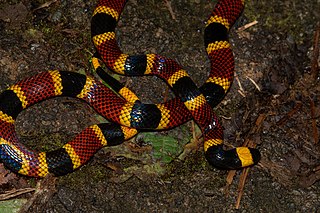
Micrurus mosquitensis, the mosquito coral snake, is a species of snake of the family Elapidae.

Micrurus multifasciatus, the many-banded coral snake, is a species of snake of the family Elapidae.





















